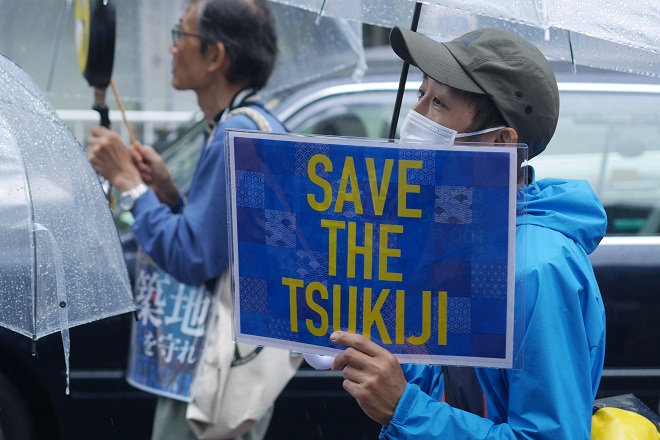Tsukiji Market, an 83-Year-Old Tokyo Icon, Set to Close
October 4, 2018
Tokyo- Tokyo's iconic Tsukiji wholesale food market will close forever on Saturday for relocation to the Toyosu district, bringing down the curtain on its 83-year history as the leading fish market in Japan.
The market in Chuo Ward opened in February 1935 after wholesale markets in the capital, including a fish market in the Nihonbashi district, were ruined by the 1923 Great Kanto Earthquake.
With about 500 kinds of seafood said to be traded, Tsukiji is the largest market in Japan in terms of trading volume, dealing in fisheries products not only from major ports across the nation but also from overseas.
In Tsukiji market's early years, railroads were the main means of shipping fish and shellfish from the market. The wholesale market building's distinctive fan-like structure is a remnant of those days.
Currently, trucks are the key method of transportation, while "turret truck" motorized shuttle carts are used to carry products inside the market.
Seafood transaction volumes expanded in line with advances in fishing and refrigeration technologies, reaching 750,000 tons in 1990, but with declines in fisheries stocks and an increase in transactions that bypass markets, the annual volume has dwindled to 400,000 tons in recent years, almost half of the peak level.
When trading was expanding in the early 1980s, a proposal was put forward to transfer Tsukiji market's functions to Ota Ward in order to resolve congestion at Tsukiji, but the plan was scrapped mainly in the face of strong opposition from related business operators.
In 1991-1995, the Tsukiji market facilities underwent renovation after it became cramped and decrepit. The renovation plan called for constructing a multistory new facility to house a fish market and a fruit and vegetable market, as well as a high-rise building to be occupied by tenants.
Prolonged work and bulging costs doomed the project, however. A revised plan was subsequently adopted, but negotiations among concerned parties on a reduced-scale overhaul of the market at the location stalled.
In 1998, an industry group of related businesses urged the Tokyo metropolitan government, which operates Tsukiji market, to look at the possibility of market relocation to a bay side area. A plan for relocation to a site in the Toyosu district of Koto Ward, some 2 kilometers away from Tsukiji, was formally decided in 2001.
Despite aging, Tsukiji market has continued operations while undergoing needed repairs.
In the celebratory New Year auction for 2013, a premium bluefin tuna caught off the town of Oma, Aomori Prefecture, northeastern Japan, one of the most renowned tuna fishing spots in the country, sold for a record high of 155.4 million yen, drawing much media and public attention.
The new market in Toyosu is scheduled to open on Oct. 11, five days after the closure of Tsukiji.
The relocation was delayed for two years from the initial plan as Tokyo Governor Yuriko Koike, who took office in August 2016, raised questions about the safety of the Toyosu market site, which previously hosted a gas plant.
After the relocation, the Tsukiji wholesale market facilities will be dismantled and the site will serve as a transportation base for the 2020 Tokyo Olympic and Paralympic Games.
In June 2017, Koike unveiled an initiative to develop part of the Tsukiji site as a food theme park, saying that Tsukiji will certainly be protected. The development is expected to utilize the strengths of both Tsukiji and Toyosu markets. Jiji Press
Latest Videos
- THE UNTOLD STORY EXPERT INSIGHTS INTO THE UKRAINE
- NEGOTIATING A NEW ORDER US RUSSIA TALKS ON UKRAIN
- Ukraine: A Pawn in the Geopolitical Game? Will Trump Intervene?
- US VP VANCE CRITICIZES EUROPEAN DEMOCRACIES AT MUNICH SECURITY CONFERENCE
- UNCOVERING THE WEB OF DECEIT: CIA INFILTRATION OF THE MEDIA
- SHIFTING SANDS: TULSI GABBARD’S CONFIRMATION AND THE EVOLVING GLOBAL LANDSCAPE
- FAUCI SCANDAL: A THREAT TO GLOBAL HEALTH AND DEMOCRACY






